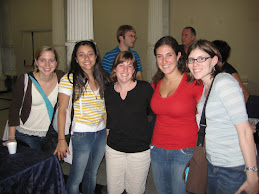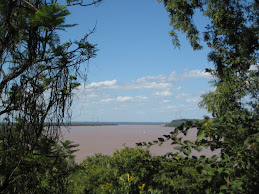My first really “touristy” trip in Argentina. Last week, I traveled by bus up to Posadas, the capital of the province of Misiones (north of my province of Entre Rios). If you’ve ever seen the movie The Mission, then you already know a little about Misiones. The movie describes what happened to some of the Jesuit missions that were established in this province back in the 16- and 1700s.
San Ignacio Mini – Ruins of a Jesuit Mission
The first thing I did in Posadas was catch a bus out to San Ignacio to see some of the best-preserved ruins in all of Misiones. The town itself of San Ignacio seemed almost deserted: barely any people were out in the streets, almost no stores were open, and there were no cars at all. Despite the lack of life in the town, the ruins were very well cared for. There’s a small museum at the entrance to the site that describes some of the history and even includes a model of the mission’s layout when it was at its peak occupation in the 1700s. The amount of work that must have gone into the building of the living quarters and church must have been immense. The most valuable part of the ruins is the remains of the entrance to the church at the head of the great central square. The intricate stonework showing the insignia of the mission as well as angels and saints is so beautiful! I was really touched by the living quarters as well. It’s amazing but also kind of sad to see the effects of time. Once this place was packed with life and activity, and now there are full-grown trees inside what used to be people’s homes. Even worse, the population of indigenous peoples in Argentina has all but disappeared, so there aren’t even many people who can legitimately connect their heritage to these missions.
Puerto Iguazú and Iguazú National Park
After spending another day in Posadas, I hopped on another bus up to Puerto Iguazu. Puerto Iguazu is located at the very northern tip of Misiones. Walking along the costanera (boardwalk), you can see where Argentina, Brazil, and Paraguay almost meet – except for the river separating them. There’s a monument with the colors of the country’s flag placed along the costanera of each country; looking from above, they would form a kind of triangle. I don’t think I’m describing it well, but it was really neat to see.
Iguazu National Park contains the most famous waterfalls in South America. I’ve never been to Niagara Falls, but from what I’ve seen in pictures, Niagara Falls can’t even compare to the falls at Iguazu. In the park, you can take two different walking paths among the falls: the lower path allows you to see the falls from below. At one point, a pier leads you so close that you can almost reach out and touch the cascading water! The upper path gives you a fabulous view of the whole expanse of waterfalls. They seem never-ending in the distance.
I don’t know much about science or nature, but I do know that these were some seriously spectacular and miraculous sights. Can you even imagine what it must have been like for the first people who discovered the falls? Whether indigenous people or Spanish conquerors, someone must have stumbled upon this place. Why did they leave????? It’s probably the closest thing to paradise that I’ll ever see on this earth.
But the sights weren’t the only things that impressed me at the National Park. This was my first trip to a truly “touristy” place in Argentina. At first, I was shocked to hear so much English being spoken. I’m not used to hearing English outside of the classes I teach or on TV, but there were tourists and vendors all speaking English in and around the park. At first, I jokingly thought to myself, “Look at all those silly tourists;” then, I realized that that’s probably exactly what the natives in town as well as the vendors were thinking about me! Considering the fact that I look nothing like the beautifully tan Argentines, I’m sure the people in Puerto Iguazu could figure out that I was a foreigner. But when vendors and tour guides started speaking to me in English without even attempting Spanish first, I had a ridiculous impulse to stamp my foot and say, “I’m not like them. Talk to me in Spanish!” Luckily, I refrained from doing that, but I tried very hard to speak in Spanish even if others started to speak to me in English. It felt strange since I know that technically I’m a foreigner, but I’m trying so hard to incorporate this country’s culture into my life that I don’t think of myself as completely foreign. Does that even make sense?
Well, overall it was a fantastic experience for my first big trip outside of Parana. I hope you’ll look at the pictures I put online because words just can’t do justice to the beauty of Misiones.
Fulbrighters in Argentina

Tuesday, May 6, 2008
Subscribe to:
Post Comments (Atom)


No comments:
Post a Comment